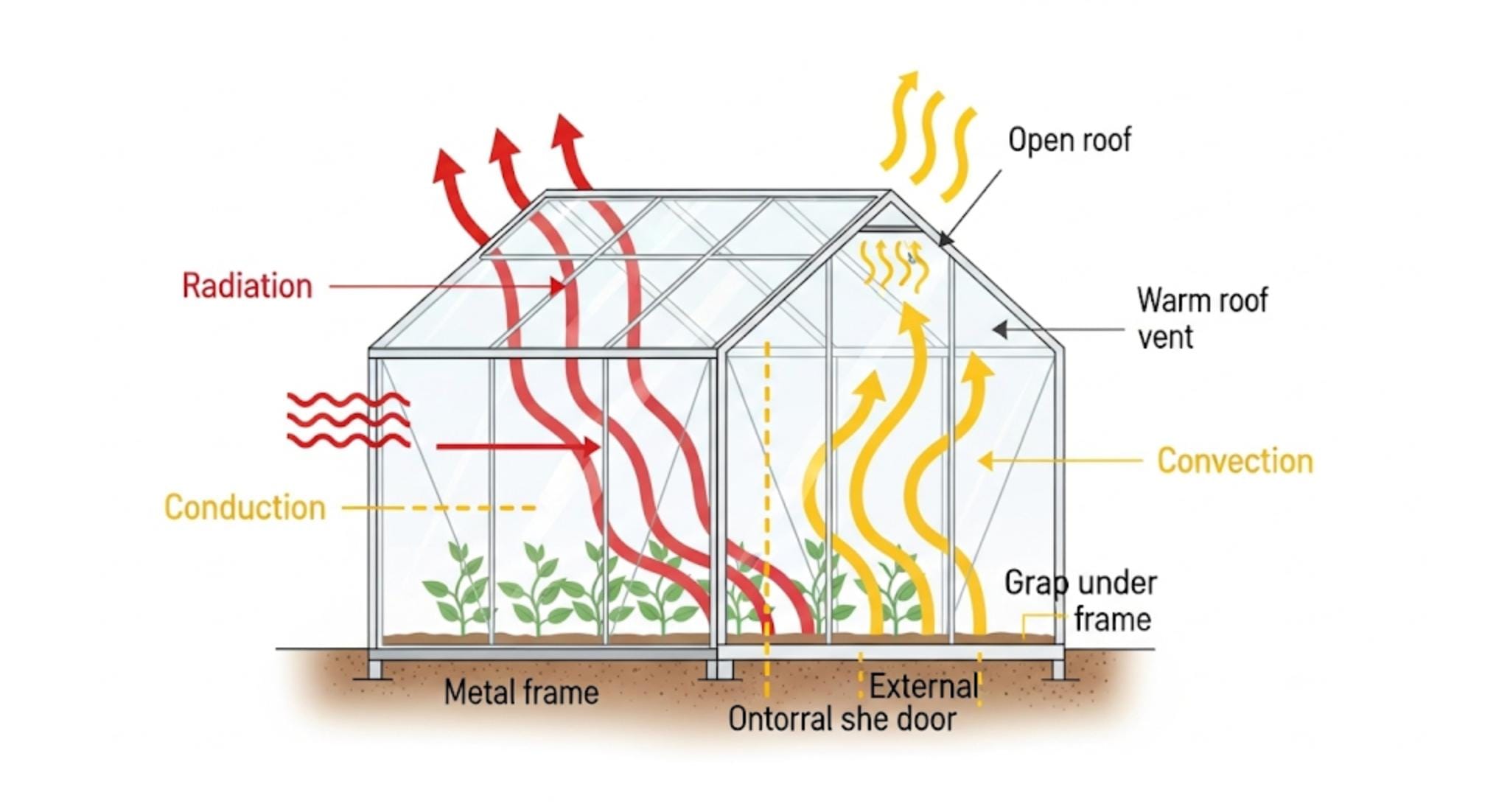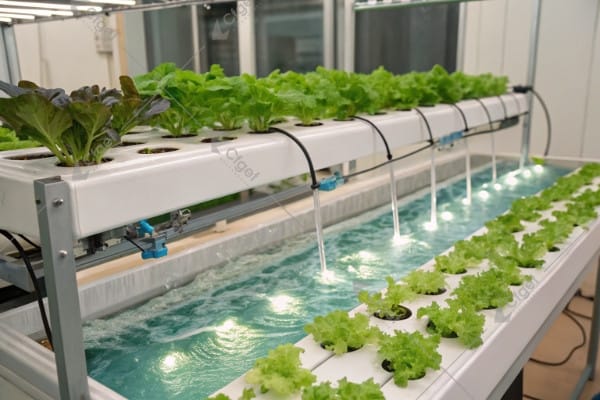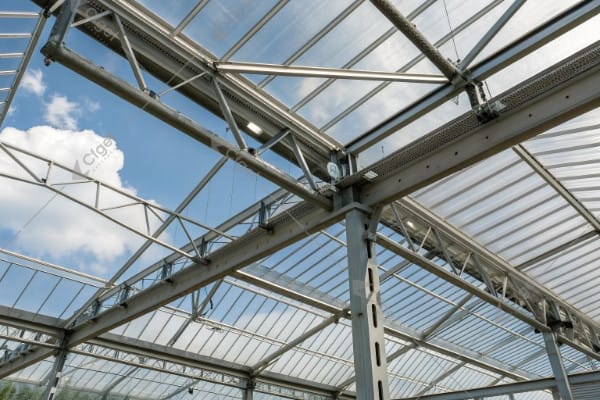Growing orchids outdoors exposes these delicate plants to unpredictable weather, pest invasions, and inconsistent conditions. Many orchid enthusiasts watch their prized collections deteriorate despite their best efforts due to environments they cannot properly control.
A greenhouse designed specifically for orchids creates a controlled microclimate that mimics their natural growing conditions. The ideal orchid greenhouse balances humidity levels (50-70%), filtered light (50-70% shade), consistent temperatures (55-85°F), and proper air circulation—all while protecting plants from pests and extreme weather.

I remember visiting a frustrated orchid collector in Vietnam who had lost several rare specimens during an unexpectedly cold week. After we installed a custom greenhouse with proper climate controls, his collection not only recovered but thrived beyond his expectations. At CFGET, we’ve designed orchid-specific greenhouses across diverse climates for over 28 years, and I’ve personally seen how the right environment transforms these finicky plants into stunning bloomers.
Don’t Miss:——How Can You Keep a Greenhouse Warm During Winter Effectively?
Mastering Humidity Control: The #1 Priority for Orchid Greenhouses?
Maintaining proper humidity for orchids in typical home or garden environments is nearly impossible. Most orchid species slowly decline when humidity levels fluctuate or drop below their comfort zone, leading to stunted growth, bud blast, and failure to bloom.
Humidity control represents the most critical aspect of successful orchid greenhouse design. The ideal setup maintains consistent humidity levels between 50-70% through integrated misting systems, proper ventilation, and moisture-retaining materials that create a stable environment mimicking orchids’ natural habitats.

The challenge of humidity management stands as the primary reason dedicated orchid enthusiasts eventually invest in specialized greenhouse structures. During my work designing custom greenhouse solutions across Southeast Asia, I’ve witnessed firsthand how proper humidity control transforms struggling orchid collections into vibrant displays.
Orchids evolved primarily as epiphytes growing on trees in tropical and subtropical forest environments. In these natural habitats, they absorb moisture through their aerial roots from the humid air rather than from soil. This evolutionary adaptation explains why dry air causes such significant stress to most orchid varieties. When relative humidity falls below 40-50%, orchids typically respond by closing their stomata (leaf pores) to prevent moisture loss. This protective mechanism also halts photosynthesis, effectively pausing growth and eventually leading to declining plant health.
Creating and maintaining ideal humidity levels requires a multifaceted approach within the greenhouse environment. Automated misting systems represent the most direct solution, providing regular bursts of fine water droplets that temporarily elevate humidity levels. In our commercial orchid greenhouse installations, we typically recommend programmable systems that activate for brief periods (15-30 seconds) multiple times daily, with frequency adjustments based on season and external weather conditions.
Evaporative surfaces play a crucial supporting role in humidity management. Water-filled trays placed beneath benches or among plants create passive evaporation that helps maintain consistent moisture levels between misting cycles. In larger commercial installations, we often install dedicated evaporation ponds or water features that serve both functional and aesthetic purposes.
The physical structure of the greenhouse itself significantly impacts humidity regulation. Proper insulation prevents rapid humidity fluctuations caused by external temperature changes. In tropical regions like Thailand, where I’ve helped design several commercial orchid operations, we focus on materials that maintain stable internal conditions despite extreme external heat. Conversely, in cooler climates, insulation prevents condensation issues that can lead to fungal problems.
Ventilation systems must carefully balance humidity retention with air exchange. This delicate equilibrium becomes particularly challenging in extreme climates. In our European installations, winter ventilation requires preheating incoming air to prevent humidity crashes, while summer ventilation must cool incoming air without excessive drying.
Don’t Miss:——Is Glass the Best Material for Your Greenhouse Structure?
Humidity Management Techniques for Different Climates
| Climate Type | Humidity Challenges | Recommended Solutions | Monitoring Approach |
|---|---|---|---|
| Tropical | Excessive humidity in wet season | Dehumidification, strategic ventilation | Digital hygrometers with data logging |
| Temperate | Seasonal fluctuations | Seasonal adjustment of misting frequency | Networked sensors with alerting systems |
| Arid | Constant low humidity | High-output misting, minimized ventilation | Wireless sensors with automated control |
| Continental | Extreme seasonal variation | Seasonal system adjustments, advanced insulation | Multi-point monitoring with climate computers |
Optimal Lighting: Balancing Sunlight, Shade, and Glazing Choices?
Many orchid growers struggle with providing consistent, appropriate light levels throughout the year. Light that’s too intense scorches delicate leaves, while insufficient light leads to weak growth and failure to bloom—a frustrating balancing act for even experienced growers.
The ideal orchid greenhouse provides filtered, diffused light that mimics the dappled forest conditions where most orchids naturally grow. This requires strategic glazing choices (typically 50-70% light transmission), supplemental lighting for winter months, and adjustable shade systems to accommodate seasonal changes and varying orchid species requirements.
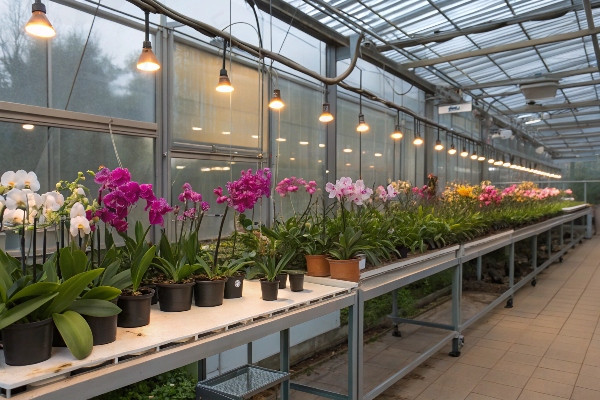
Light management represents a defining factor in orchid greenhouse success. Throughout my career designing orchid growing environments for both commercial producers and serious collectors, I’ve found that sophisticated light control often separates thriving operations from struggling ones.
Orchids have evolved specific light preferences based on their native growing conditions. Most popular varieties originated as understory plants receiving filtered light through forest canopies. This natural history explains why direct, intense sunlight damages their foliage while insufficient light inhibits flowering. Creating this "Goldilocks zone" of ideal light conditions requires thoughtful greenhouse design from the earliest planning stages.
Glazing material selection forms the foundation of light management strategy. Traditional glass offers excellent light transmission but poor insulation and diffusion properties. Modern polycarbonate panels provide superior insulation while diffusing light more effectively—reducing hotspots and improving light distribution throughout the growing space. In our recent installation for a major orchid breeder in Thailand, we utilized twin-wall polycarbonate with a light transmission rate of 65%, which dramatically improved growth uniformity across their collection.
The geometric orientation of the greenhouse structure itself significantly impacts light patterns throughout the year. In Northern Hemisphere locations, south-facing glazed areas receive maximum winter light but require additional summer shading. East-west orientations provide more consistent year-round light but may create challenging morning and evening sun exposure. When designing for clients with diverse orchid collections, we often recommend ridge orientations that optimize light distribution based on specific site conditions and operation goals.
Shade systems represent the most flexible component of light management strategy. These range from simple exterior shade cloth to sophisticated computerized internal systems. For commercial orchid producers, we typically recommend automated shade systems that adjust based on light sensor readings, maintaining ideal conditions regardless of external weather. The ability to create multiple shade zones within a single greenhouse structure allows for housing diverse orchid species with varying light requirements.
Supplemental lighting becomes essential in many climates, particularly for winter production in temperate regions. Modern LED technology offers tremendous advantages for orchid growing, providing specific light spectrums tailored to orchid growth and flowering phases. In a recent project for a European orchid collector, we installed a programmable LED system that gradually adjusts light intensity and spectrum throughout the day, mimicking natural sunrise and sunset patterns—a feature that significantly improved flowering consistency in their Phalaenopsis collection.
For serious orchid enthusiasts, creating multiple light zones within a single greenhouse structure maximizes versatility. In my design work, I often incorporate permanent shade areas for shade-loving species like Paphiopedilums alongside brighter zones for light-hungry varieties like Vandas. This zoned approach allows collectors to expand their variety range without compromising growth quality.
Light Requirements for Common Orchid Types
| Orchid Type | Natural Habitat | Light Intensity Needs | Ideal Greenhouse Placement |
|---|---|---|---|
| Phalaenopsis | Forest understory | Low (10,000-15,000 lux) | Heavily shaded areas |
| Cattleya | Semi-exposed branches | Medium-high (20,000-30,000 lux) | Moderate shade areas |
| Dendrobium | Varied by species | Medium (15,000-25,000 lux) | Moderate shade areas |
| Vanda | Exposed branches | High (25,000-35,000 lux) | Brightest areas with minimal shade |
| Paphiopedilum | Forest floor | Very low (8,000-12,000 lux) | Heavily shaded, cool areas |
Temperature & Airflow Management for Healthy Orchid Growth?
Temperature fluctuations and stagnant air create perfect conditions for orchid diseases and stress. Many growers lose plants to rot, fungal infections, or slow decline because their growing environment lacks proper thermal stability and air movement.
Successful orchid greenhouses maintain temperatures between 55-85°F (12-29°C) with no more than 15°F daily fluctuation, while ensuring constant gentle air movement around plants. This requires integrated heating, cooling, ventilation systems, and circulation fans working together to create a stable, dynamic environment.

Temperature management and airflow work as interrelated systems that directly impact orchid health and flowering. In my experience designing climate control solutions for both commercial and hobbyist orchid greenhouses, I’ve found that these factors often determine long-term success more than any other variables except humidity.
Orchids have evolved remarkable temperature adaptations based on their native growing zones. High-elevation species like many Cymbidiums and Masdevallias require cool nights to trigger flowering, while lowland tropical varieties like Phalaenopsis and Vandas thrive in consistently warm conditions. A well-designed greenhouse accommodates these varied needs through temperature zoning and precise control systems.
Heating systems require careful selection based on climate and operation scale. For small hobby greenhouses in moderate climates, electric heaters with built-in thermostats often suffice. For larger commercial operations, we typically recommend more sophisticated options. During a recent installation for a major orchid producer in Central Europe, we implemented a hydronic radiant floor system that provides gentle, uniform heat without drying the air—a crucial consideration for orchid health.
Cooling presents greater challenges than heating in most locations. Passive cooling through roof vents and side wall openings works effectively in mild climates but becomes insufficient during extreme heat. Evaporative cooling systems (wet walls and fans) offer affordable solutions in dry climates by simultaneously cooling and humidifying the air. In one memorable project for a collector in Arizona, our evaporative system maintained ideal conditions despite external temperatures exceeding 110°F (43°C).
In humid tropical regions where many of our clients operate, mechanical cooling becomes necessary despite its higher operational costs. During my work with a commercial Dendrobium producer in Thailand, we installed a hybrid system combining mechanical cooling for critical areas with evaporative and passive cooling for others—optimizing both growing conditions and energy efficiency.
Air circulation represents the often-overlooked component of environmental management. Even with ideal temperature and humidity, stagnant air around orchid foliage invites fungal and bacterial problems. Horizontal airflow fans (HAF) create gentle, continuous air movement that strengthens stems, reduces disease pressure, and ensures uniform conditions throughout the growing space. I always recommend circulation fans that create air movement of about 3-5 feet per second—strong enough to prevent microclimates around plants but gentle enough to avoid excessive transpiration.
The integration of these systems through automated climate controls1 represents the gold standard for serious orchid production. Modern climate computers monitor multiple parameters simultaneously, adjusting heating, cooling, ventilation, and circulation components to maintain ideal conditions. While visiting a state-of-the-art orchid breeding facility in Taiwan, I observed how their integrated system maintained remarkably stable conditions despite typhoon conditions outside—a testament to the power of properly designed environmental controls.
Temperature Requirements by Orchid Category
| Temperature Category | Daytime Range | Nighttime Range | Representative Genera | Climate Control Needs |
|---|---|---|---|---|
| Cool Growing | 60-70°F (15-21°C) | 50-55°F (10-13°C) | Cymbidium, Masdevallia | Cooling priority, night drop essential |
| Intermediate | 70-80°F (21-27°C) | 55-65°F (13-18°C) | Oncidium, Miltonia | Balanced heating and cooling |
| Warm Growing | 75-85°F (24-29°C) | 65-70°F (18-21°C) | Phalaenopsis, Vanda | Heating priority, minimal fluctuation |
Benching & Setup: Designing the Interior for Your Orchid Collection?
Poor greenhouse interior design forces growers to compromise plant care, workspace functionality, and collection organization. Many enthusiasts find themselves struggling with inadequate bench space, inefficient layouts, and difficulties maintaining different growing zones for varied orchid types.
The interior design of an orchid greenhouse should maximize growing space while ensuring easy access to all plants, accommodate various container types, and create distinct microclimate zones. Raised benches with open-grid tops improve air circulation, while tiered configurations increase capacity without compromising light distribution.
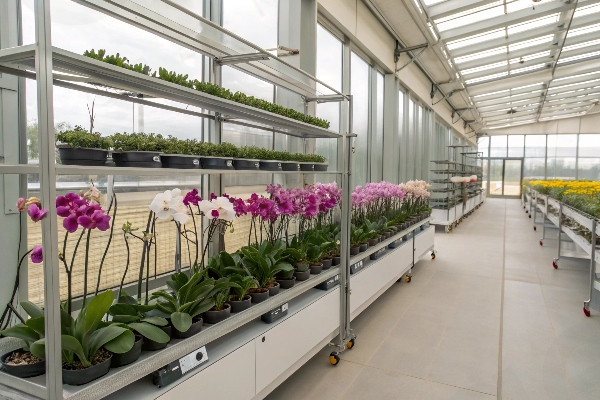
The interior layout fundamentally impacts both plant health and grower experience within the greenhouse. After nearly three decades helping orchid enthusiasts and commercial growers design their growing spaces, I’ve found that thoughtful interior configuration often separates sustainable, expanding collections from frustrated, limited ones.
Bench systems form the core infrastructure within the orchid greenhouse. Unlike some crops grown directly in soil beds, orchids require elevated growing surfaces for proper drainage, air circulation, and convenient access. The bench design2 must balance several competing factors: maximizing growing space, ensuring adequate plant spacing, providing proper drainage, and facilitating easy maintenance access.
Material selection for benching significantly impacts long-term performance and plant health. Galvanized steel frames with food-grade plastic mesh tops represent our most recommended configuration for serious collectors. This combination resists corrosion from constant moisture, provides excellent drainage, and supports proper air movement around containers. During a recent installation for a Phalaenopsis breeder in Vietnam, we implemented a custom bench system with adjustable-height sections that allowed workers to position plants at optimal heights for different growth stages.
Vertical space utilization through tiered or hanging systems dramatically increases growing capacity without expanding the greenhouse footprint. For hobbyists with diverse collections, we often recommend a combination of traditional benches and suspended growing areas. Hanging systems work particularly well for pendant-growing orchids like many Dendrobiums and Bulbophyllums, freeing bench space for pot-grown varieties. One innovative collector in Malaysia increased his growing capacity by nearly 40% after implementing our custom tiered bench and hanging rail system.
Workspace integration within the growing area requires careful planning. Potting stations, storage areas, and maintenance zones must balance convenience with space efficiency. In commercial operations, we typically recommend dedicated work areas with proper ergonomic design to facilitate efficient plant handling. For hobbyists with space constraints, convertible potting areas that double as display space offer practical compromises.
Microclimate zoning represents an advanced design concept that significantly enhances collection versatility. By strategically positioning benches relative to heating, cooling, and ventilation components, distinct temperature and humidity zones can be created within a single greenhouse structure. During my consultation with an orchid society in Europe, we redesigned their community greenhouse to include three distinct growing zones—allowing members to grow everything from cool Masdevallias to warm Vandas in the same structure.
Water management systems must integrate seamlessly with bench layout. Proper drainage channels beneath benches prevent standing water while capturing runoff for potential reuse. In our commercial designs, we often implement slight bench slopes (1-2%) to facilitate drainage toward collection channels. For environmentally conscious collectors, we can design closed-loop systems that filter and recirculate irrigation water—reducing both water usage and fertilizer costs.
The physical movement patterns of growers within the space deserve careful consideration. Aisles must accommodate comfortable access for routine care while maximizing growing space. The standard recommendation of 30-36" (76-91cm) aisle width balances these competing needs for most hobbyists, while commercial operations typically require wider pathways for carts and equipment.
Bench System Comparison for Orchid Greenhouses
| Bench Type | Advantages | Limitations | Best For |
|---|---|---|---|
| Fixed Height, Open Mesh | Excellent drainage, good airflow, simple construction | Less versatile for mixed collections | General collections, commercial production |
| Multi-Tier, Adjustable | Maximizes space utilization, creates micro-environments | Higher cost, more complex installation | Diverse collections, limited space situations |
| Rolling/Mobile Benches | Maximizes floor space, allows reconfiguration | Requires level flooring, higher initial cost | Commercial operations, serious collectors |
| Specialized Display Benches | Enhances presentation, integrated water features | Less practical for everyday growing | Collection showpieces, visitor areas |
Conclusion
The ideal orchid greenhouse balances humidity, light, temperature, airflow, and interior design to create a protected environment mimicking natural habitats. By carefully controlling these critical factors through appropriate systems, orchid growers can achieve remarkable results regardless of external climate challenges.

